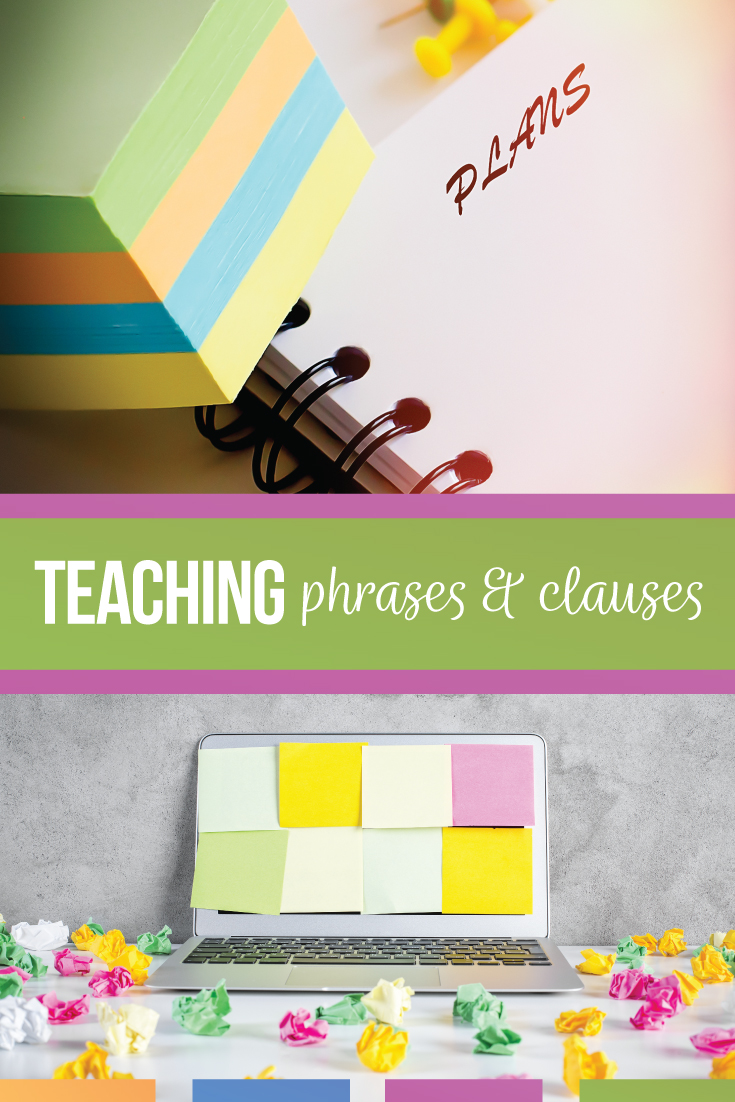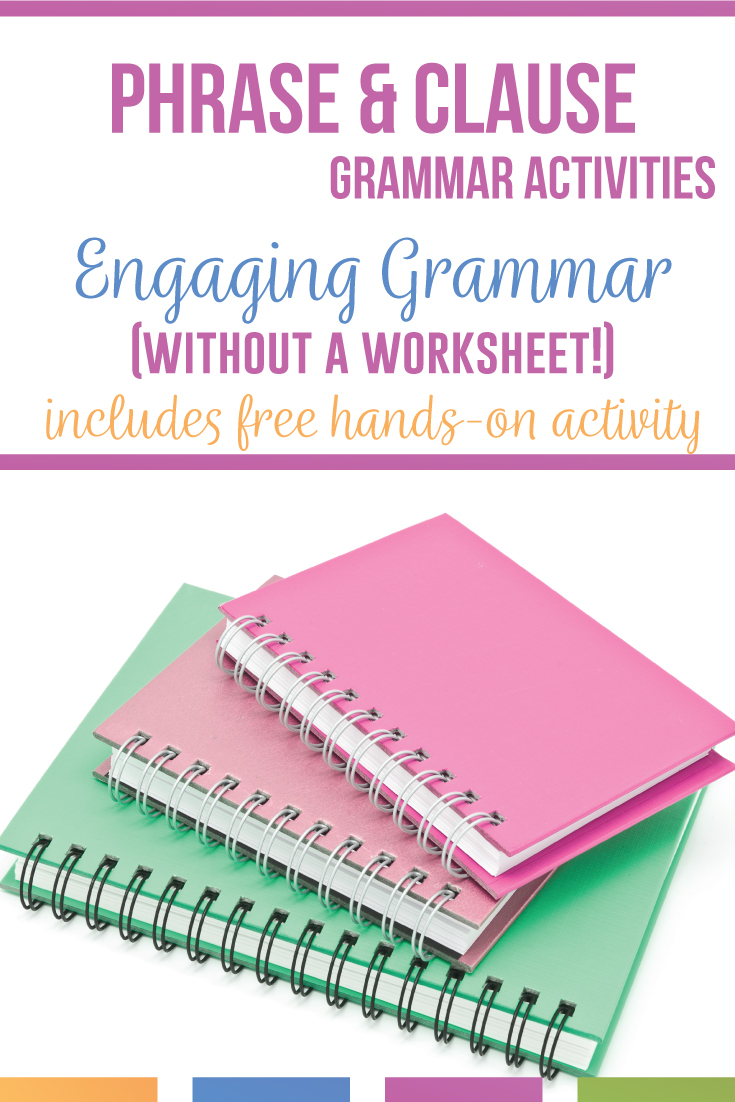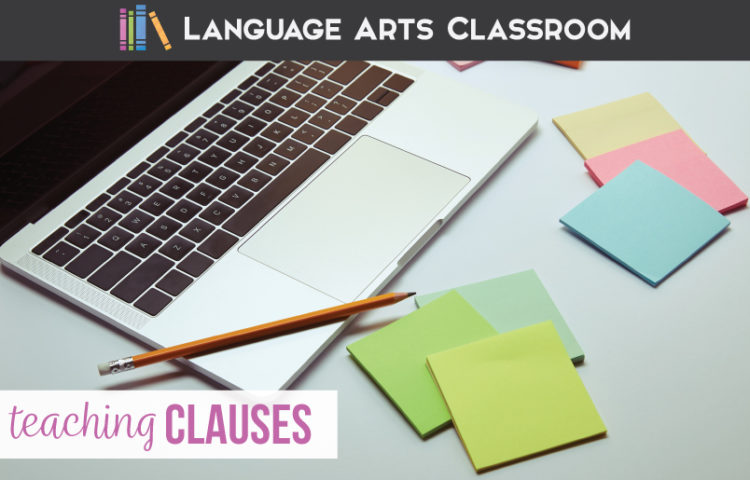Teaching clauses: independent and dependent clauses are an important part of sentence structure lessons. With these lessons, you’ll also be teaching important punctuation and parallelism rules in addition to teaching clauses and phrases.
I always explain grammar lessons like this: The study of language never ends. We might talk about the eight parts of speech, but throughout years of study, some taught nine parts of speech and others taught fewer. In fact, standards require that ELA teachers discuss how language changes.
After we look at the parts of speech, we can break words down into parts of a sentence, and all of that is before we even begin looking at sentences. Phrases and clauses are the words we’ve already studied put together.
Typically, teaching clauses and phrases happens in seventh grade language arts. Most seventh grade language standards also focus on sentence structure, and those lessons also lend themselves to phrases and clauses’ discussions. So! Older learners probably are familiar with phrases and clauses.
Still, we review.
Should I be reviewing and teaching clauses and phrases?
Probably, yes. You will need to cover both groups of words (phrases and clauses) before you dive into clause lessons. Plus, only an independent clause is a complete thought, something important to share.
First, an overview will provide the basis of ideas and terms for all students. By providing an overview, I am explaining to students where we are in our study and am showing them where we are going. I’m also providing tools for students who might want to study linguists or a foreign language in college.
Furthermore, I’m building off prior knowledge; when we study clauses, we are studying the togetherness of other concepts that we’ve already covered! Basically, I’m trying to reach multiple students in multiple ways.
Reviewing Conjunctions and Commas
Build off prior knowledge with a review of some basic concepts.
Conjunction task cards, for instance, help students with relevant information before jumping into different types of clauses and phrases. Since conjunctions join words, phrases, and clauses, they are an important review.
Commas (and their rules!) are necessary for working with introductory subordinate clauses and phrases.
Other prior knowledge, perhaps finding the subject of the sentence or identifying complete sentences, will empower your students too. Add whatever additional information your particular group of learners needs.
Teaching Phrases
Before teaching clauses, I review phrases, but I know some teachers teach clauses after studying subjects and verbs. Other teachers teach clauses in conjunction with sentence structure. Your plans might differ based on your standards, classes, and time frame.
For instance, if you’re trying to meet language standards, you are probably working toward using various types of phrases and clauses in writing, explaining phrases and clauses and their functions, and correcting errors concerning them.
Both phrases and clauses can require specific punctuation, and students should apply both concepts to their writing. Assess your situation and decide what will work for your classes.
I think of teaching clauses and phrases like this: We are building off prior knowledge. Students can feel success, and then we can dive into more specific aspects.
Teaching Clauses
Below, I’ve included my overall lesson for teaching clauses with older students, probably freshmen or sophomores. Students need to understand clauses before they tackle sentence structure, but older students typically work on applying punctuation rules and identifying specific clauses.
Use these ideas, samples, and talking points for the next time you are teaching clauses.
Phrases
I don’t provide direct instruction on every type of phrase when we start clause lesson plans. With high school students, we primarily work with participial, infinitive gerund, prepositional, and appositive phrases. Older students normally understand prepositional phrases, so I build on that prior knowledge. However, if students confuse phrases and clauses, I will bring out a phrases and clauses lesson plan to end confusion.
As we cover verbals, I don’t draw a hard line between “verbals” and “verbal phrases.” Overall, students understand that a word will have modifiers, and the flow to identifying verbal phrases is easy.
Students should understand phrases so that they can diversify their writing, use punctuation correctly, and prevent misplaced and dangling modifiers. To illustrate those points, I experiment with phrases. The more students experiment with their writing, the more empowered they are, so I will cover different phrases with students. Look at these phrases in action:
The puppy loves to play with her bone. (infinitive phrase)
Playing with her bone, the puppy bounded around the room. (participial phrase)
Playing with her bone made the puppy happy. (gerund phrase)
To review phrases, I sometimes ask students to present a sentence from their writing in different ways. It is an effective way to apply grammar to writing, to review concepts, and to evaluate the effectiveness of different tools.
The move from phrases to clauses is often a smooth one. Students grasp the idea that groups of words can function together. After studying phrases, next move to studying clauses.
Phrases and Clauses
First, decide where you should begin with phrases and clauses. Students don’t always confuse phrases and clauses, so I don’t always cover the differences with a specific lesson. If I need to scaffold clause lessons, however, my first stop is normally to identify the differences between phrases and clauses. Drawing the distinction between groups of words can end some confusion. For instance, when students continually write phrases instead of dependent clauses, I highlight the differences:
After dinner, we grabbed ice cream. (phrase)
After we finished dinner, we grabbed ice cream. (clause)
No matter what field students enter, they will differentiate between details, and phrases and clauses require students to pay attention to details. A phrase and a clause are different. A phrase is a group of words without a subject and a verb. A clause is a group of words with a subject and a verb. Students can decide if a phrase or a clause works best in a sentence. (Show them the above lessons and ask them for their thoughts.)
Asking students to apply grammar to writing and then evaluate the effect moves grammar from the base of Bloom’s Taxonomy to the top. If you are in the middle of a grammar lesson about phrases and clauses, take the opportunity to write a few sentences and apply them. (Doing this also makes a great transition in class.)
We’ll practice and review phrases. Students normally can write phrases. This part of the clause lesson is often a confidence booster, a build on prior knowledge. Then we work specifically toward independent clauses. Doing so allows me to build on concepts that students already know, such as simple sentences.

Clauses Lesson Plan
After phrases and clauses activities, we move to a focus on clauses. Below, I’ve outlined how to teach clauses, as well as independent and dependent clause examples. So often, teachers need an overview of talking points for their clauses lesson plan. Add these definitions and examples to your material.
Independent Clause Examples
An independent clause contains a subject and a verb and make sense by itself. Students write a clause every time they write a simple sentence.
Brayden joined his sister at the carnival, (for) she held all the ride tickets.
Emilee broke a glass, (so) she cleaned up the mess.
While teaching, I would write those two sentence. (If I am comfortable with the topic, I would allow student to give me four independent clauses. Feel free to use those sentences in your clauses lesson plan!) After we have our independent clauses, I would turn them into compound sentences like I did above.
A fun grammar activity is to give each student a few note cards. Ask students to write one independent clause per note card. Then, put the independent clauses together with a conjunction for memorable compound sentences.
Then, we continue to study dependent clauses, or a clause that cannot stand alone. (It is a “dependent.” It depends on the independent clause to make sense.) We review relative pronoun and subordinating conjunctions, often with a presentation. We slowly turn those independent clauses into dependent clauses.
Dependent Clause Examples
Brayden joined his sister at the carnival because she held all the ride tickets.
After Emilee broke a glass, she cleaned up the mess.
With both of those examples, I added subordinating conjunctions. Provide a list for students of subordinating conjunctions and add them to independent clauses. A few well-placed clause worksheets that ask students to identify subordinating conjunctions will also cement their knowledge.
A goal with grammar is to inspire students. Show students that understanding their language is within their reach. Take the opportunity to play with independent and dependent clauses. Punctuate them correctly. Let students experiment and write funny sentences.
If you aren’t ready to write clauses without support, that’s ok! Take some of the samples from a grammar worksheet and play with them. Knock off the subordinating conjunction from a dependent clause, and you’ll have an independent clause. Add a subordinating conjunction to an independent clause, and you’ll have a dependent clause.

When students are comfortable with subordinating conjunctions, you should introduce relative pronouns. (Students maybe have studied them before.) Students should recognize subordinating conjunctions and relative pronouns before they move to noun, adjective, and adverb clauses.
Clause Manipulation
Types of clauses are difficult. I find adjective and adverb clauses easy to write, but I have to be intentional with noun clauses. If I find them tough, I know my students do too. So, I scaffold the process, down to providing a graphic organizer for note sheets that breaks down each part of particular clauses. Additionally, I provide the lists of subordinating conjunctions and relative pronouns for students.
I frontload information with definitions, lists, examples, and punctuation rules.
After we have the basics of types clauses, we review them before moving to grammar manipulations:
- Noun clauses have “noun jobs.” (Subject, direct object, indirect object, object of the preposition, predicate noun, appositive.)
- Students typically can identify adjective and adverb clauses, especially when they introduce a sentence. An introductory clause is followed with a comma.
- Dependent clauses cannot stand alone.
Then, we build sentences intentionally with types of clauses. I have pre-made independent clauses along with noun, adjective, and adverb clauses in a Powerpoint. I color-code them (print them on colored paper), and then students and I make sentences together. We physically move the clauses and experiment with building these sentences. This process is hands-on, and students appreciate working with their peers for support.
A great activity for using those grammar manipulatives is to ask students to take photos of their best creations. Ask students to send or air drop them to you. Then, assemble those pictures in a Google Slides presentation. You can share the presentation to start class the next day, to review types of clauses, or to build into a sentence structure lesson. Plus, you can share the entire presentation with your students.
Higher Order Thinking and Clauses
Once students understand clauses, you can advance their thinking. Grammar lessons should never end with identification, with a basic grammar worksheet! When students are comfortable with clauses, next move to application and analysis (and beyond!) Try:
- Write this concept as a phrase, and then write it as a dependent clause.
- Turn this phrase into a clause. Does the punctuation change?
- Evaluate which use best conveys your message.
- Decide what sentence structure best provides transitions for your paper.
Spend some time playing with language. For example, start with a previous sentence:
Emilee broke a glass, so she cleaned up the mess.
Then manipulate the sentence:
After breaking a glass, Emilee carefully cleaned up the mess.
Students can elevate their understanding of language and grammar with a bit of prompting, and you can connect grammar to writing. Those note cards in which students wrote independent clauses? Pull those back out and add phrases and clauses to them.
My final pep talk for these grammar activities!
Working with grammar lessons in so many ways might at first seem forced but eventually, you will ask questions about grammar or prompt students to switch concepts. Whatever part of ELA class you find natural, with a bit of practice, you will approach such grammar holistically and naturally, promise.
The first few times through a grammar lesson, you might feel overwhelmed. Take notes with you, and model for students that you are willing to look up definitions and videos for support.

Teachers typically teach clauses after students understand parts of speech, parts of a sentence, and phrases, placing clause grammar lessons during the third quarter or second half of a school year. This makes sense! Students are starting to put pieces of grammar together. Your teaching is paying off, and students are developing a strong foundation of understanding their language. You’re probably ready to work on sentence structure.
Finally, teachers often ask me when I teach usage. Honestly, I teach usage alongside concepts, and teaching clauses is the perfect time for usage. For instance, when I teach phrases, we work on comma use. Similarly, when I teach clauses, we cover commas with introductory dependent clauses. A clauses lesson plan is complex because so many elements work into it.
Once you get into teaching clauses and phrases, you will anticipate what activities students need.







